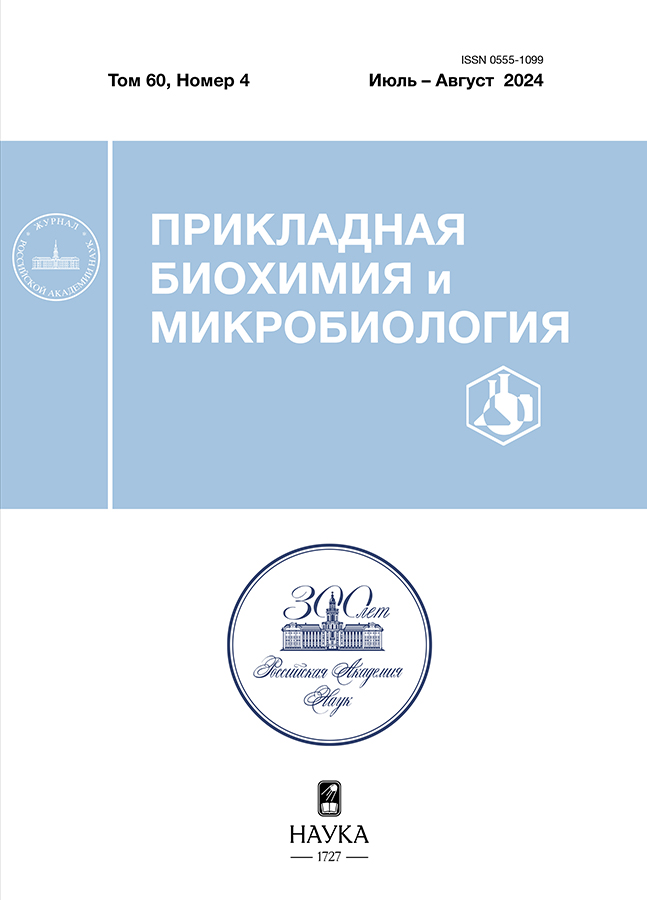Development of a method for detection and quantitative analysis of engeneered endolysin LysAm24-SMAP in biological samples
- Авторлар: Klimova A.A.1,2, Grigoriev I.V.1, Vasina D.V.1, Anurova M.N.2, Gushchin V.A.1,3, Antonova N.P.1
-
Мекемелер:
- Gamaleya National Research Centre for Epidemiology and Microbiology, Ministry of Health of the Russian Federation
- Sechenov First Moscow State Medical University (Sechenov University), Ministry of Health of the Russian Federation
- Lomonosov Moscow State University
- Шығарылым: Том 60, № 4 (2024)
- Беттер: 413-423
- Бөлім: Articles
- URL: https://journals.eco-vector.com/0555-1099/article/view/674547
- DOI: https://doi.org/10.31857/S0555109924040108
- EDN: https://elibrary.ru/RZYKWW
- ID: 674547
Дәйексөз келтіру
Аннотация
In recent years modified bacteriophage lysins are widely investigated for the purposes of antibacterial therapy development. Thus, effective and precise methods for the quantitative analysis of these enzymes are of high demand. The enzyme-linked immunosorbent assay (ELISA) method has been developed for the detection of recombinant modified endolysin LysAm24-SMAP in biological samples. The optimal parameters for protein detection were determined, particularly, the influence of salt and the composition of the buffer system for samples preparation was studied. The applicability of the immunodetection system of the genetically engineered endolysin LysAm24-SMAP in various biological samples with enzyme concentrations from 0.4 ng/ml was demonstrated. Also, the influence of matrix effects in animals’ organs and tissues homogenates samples, producer strain lysates and their individual components during the analysis was assessed and it was shown that 0.65 M NaCl addition in the ELISA buffer is crucial for achieving correct results and reduces non-specific interactions in the case of LysAm24-SMAP. The effectiveness of the developed system in the immunochemical control of the bacteriolytic enzyme was confirmed.
Негізгі сөздер
Толық мәтін
Авторлар туралы
A. Klimova
Gamaleya National Research Centre for Epidemiology and Microbiology, Ministry of Health of the Russian Federation; Sechenov First Moscow State Medical University (Sechenov University), Ministry of Health of the Russian Federation
Email: northernnatalia@gmail.com
Ресей, Moscow, 123098; Moscow, 119991
I. Grigoriev
Gamaleya National Research Centre for Epidemiology and Microbiology, Ministry of Health of the Russian Federation
Email: northernnatalia@gmail.com
Ресей, Moscow, 123098
D. Vasina
Gamaleya National Research Centre for Epidemiology and Microbiology, Ministry of Health of the Russian Federation
Email: northernnatalia@gmail.com
Ресей, Moscow, 123098
M. Anurova
Sechenov First Moscow State Medical University (Sechenov University), Ministry of Health of the Russian Federation
Email: northernnatalia@gmail.com
Ресей, Moscow, 119991
V. Gushchin
Gamaleya National Research Centre for Epidemiology and Microbiology, Ministry of Health of the Russian Federation; Lomonosov Moscow State University
Email: northernnatalia@gmail.com
Ресей, Moscow, 123098; Moscow, 119991
N. Antonova
Gamaleya National Research Centre for Epidemiology and Microbiology, Ministry of Health of the Russian Federation
Хат алмасуға жауапты Автор.
Email: northernnatalia@gmail.com
Ресей, Moscow, 123098
Әдебиет тізімі
- Gerstmans H., Rodríguez-Rubio L., Lavigne R., Briers Y. // Biochem. Soc. Trans. 2016. V. 44. P. 123–128. https://doi.org/10.1042/BST20150192
- Love M.J., Bhandari D., Dobson R.C.J., Billington C. // Antibiotics (Basel). 2018. V. 7. № 1. 17. https://doi.org/10.3390/antibiotics7010017.
- Huemer M., Shambat S.M., Brugger S.D., Zinkernagel A.S. // EMBO Rep. 2020. e51034. https://doi.org/10.15252/embr.202051034
- Baquero F. // Int. Microbiol. 2021. V. 24. P. 499–506. https://doi.org/10.1007/s10123-021-00184-y
- Antonova N.P., Vasina D.V., Lendel A.M., Usachev E.V., Makarov V.V., Gintsburg A.L. et al. // Viruses. 2019. V. 11. № 3. https://doi.org/10.3390/v11030284
- Gutiérrez D., Briers Y. // Curr. Opin. Biotechnol. 2021. V. 68. P. 15–22. https://doi.org/10.1016/j.copbio.2020.08.014
- Fursov M.V., Abdrakhmanova R.O., Antonova N.P., Vasina D.V., Kolchanova A.D., Bashkina O.A. et al. // Viruses. 2020. V. 12. P. 545. https://doi.org/10.3390/v12050545
- Tabatabaei M.S., Ahmed M. // Methods Mol. Biol. 2022. 2508. P. 115–134. https://doi.org/10.1007/978-1-0716-2376-3_10
- Antonova N.P., Vasina D.V., Rubalsky E.O., Fursov M.V., Savinova A.S., Grigoriev I.V. et al. // Biomolecules. 2020. V. 10. P. 440. https://doi.org/10.3390/biom10030440
- Dawson R.M., Liu C.Q. // Drug Dev. Res. 2009. V. 70. P. 481–498.
- Vasina D.V., Antonova N.P., Grigoriev I.V., Yakimakha V.S., Lendel A.M., Nikiforova M.A. et al. // Front. Microbiol. 2021. V. 12. https://doi.org/10.3389/fmicb.2021.748718
- Arshinov I.R., Antonova N.P., Grigoriev I.V., Pochtovyi A.A., Tkachuk A.P., Gushchin V.A. et al. // Applied Biochemistry and Microbiology. 2022. V. 58. Suppl. 1. https://doi.org/10.1134/S0003683822100027
- Alves N.J. // Antib Ther. 2019. V. 2 P. 33–39. https://doi.org/10.1093/abt/tbz002
- Minas K., McEwan N.R., Newbold C.J., Scott K.P. // FEMS Microbiol. Lett. 2011. V. 325. P. 162–169. https://doi.org/10.1111/j.1574-6968.2011.02424.x
- Li G., Howard S.P. // Methods Mol. Biol. 2017. V. 1615. P. 143–149.
- Jun S.Y., Jung G.M., Yoon S.J., Youm S.Y., Han H.-Y., Lee J.-H. et al. // Clin Exp Pharmacol Physiol. 2016. V. 43. P. 1013–1016. https://doi.org/10.1111/1440-1681.12613
- Grishin A.V., Lavrova N.V., Lyashchuk A.M., Strukova N.V., Generalova M.S., Ryazanova A.V. et al. // Molecules. 2019. V. 24. https://doi.org/10.3390/molecules24101879
- Ross G.M. S., Filippini D., Nielen M.W.F., Salentijn G.I. // Anal. Chem. 2020. V. 92. P. 15587–15595. https://doi.org/10.1021/acs.analchem.0c03740
- Adhya S., Merril C. R., Biswas B. // Cold Spring Harb. Perspect Med. 2014. V. 4. https://doi.org/10.1101/cshperspect.a012518
- Höltje J.-V. // Arch. Microbiol. 1995. V. 164. P. 243–254. https://doi.org/10.1007/BF02529958
- Chen T., Rao, Y., Li J., Ren C., Tang D., Lin T. et al. // Int. J. Mol. Sci. 2020. V. 21. https://doi.org/10.3390/ijms21020501
- Callewaert L., Michiels C.W. // J. Biosci. 2010. V. 35. P. 127–160. https://doi.org/10.1007/s12038-010-0015-5
- Liu R., Meng Q., Dai Y., Zhang Y. // Chinese journal of biotechnology. V. 39. P. 4482–4496. https://doi.org/10.13345/j.cjb.230241
- Xu H., Lu J.R., Williams D.E. // J. Phys. Chem. B. 2006. V. 110. P. 1907–1914. https://doi.org/10.1021/jp0538161
- Generalova L.V., Grigoriev I.V., Vasina D.V., Tkachuk A.P., Kruzhkova I.S., Kolobukhina L.V. et al. // Bulletin of RSMU. 2022. V. 1. P. 14–21. https://doi.org/10.24075/brsmu.2022.005
- Gushchin V.A., Ogarkova D.A., Dolzhikova I.V., Zubkova O.V., Grigoriev I.V., Pochtovyi A.A. et al. // Front Immunol. 2022. V. 13. https://doi.org/10.3389/fimmu.2022.1023164
- Antonova N., Vasina D., Lendel A., Usachev E., Makarov V., Gintsburg A. et al. // Viruses. 2019. V. 11. https://doi.org/10.3390/v11030284
- Stiller J., Jasensky A.-K., Hennies M., Einspanier R., Kohn B. // J. Vet. Diagn. Invest. 2016. V. 3. P. 235–243. https://doi.org/10.1177/1040638716634397
- Biswas S., Saha M.K. // Immunochemistry & Immunopathology. 2015. V. 1. https://doi.org/10.4172/icoa.1000109
Қосымша файлдар









